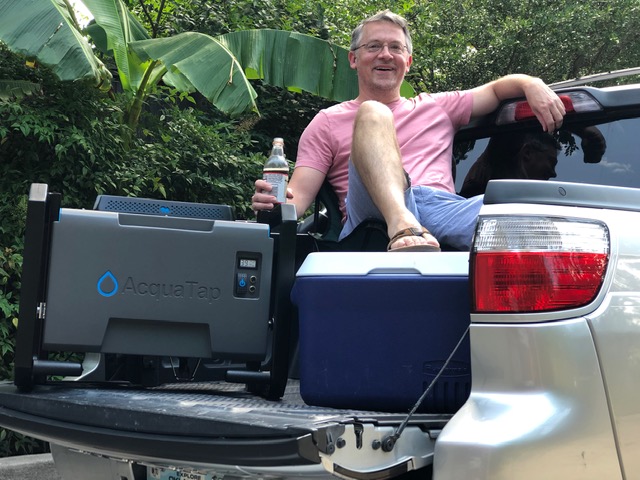CES, the leading gadget show in the country, promises no shortage of new TVs, exoskeletons, headphones, and even emotional robots that might be a great companion for your child. But beyond the bleeding-edge gadgets and consumer electronics, there are a number of companies using high tech to solve the lowest of problems: There’s simply not enough clean drinking water in the world.
Some 20% of people reportedly lack access to drinking water, and can’t simply “turn on the faucet.” Meanwhile, corporations around the globe contaminate more water than they ever purify. Fortunately, tech can help, thanks to companies like Exaeris Water Innovations, which last year announced and this year plans to roll out the AcquaTap, a remarkable portable system for pulling water directly from the air all around you. The device can make up to 5 gallons per day, the company says.
“An affordable device that’s available to millions of people around the world … that’s a game-changer. That’s a lifesaver,” Mike Joyce, chief operating officer for the company, told Digital Trends. We’ve written about ways to do this in the past, of course. In 2018, Digital Trends reported on an invention from MIT that pulls water from thin air, and a nanofiber cloth with similar capabilities, invented by researchers at Ohio’s University of Akron. But turning it into a product you can buy? Something about the size of a cooler that costs less than $2,000? That’s next-level.
Solving the world’s water problems is something you can help with at your own home, of course. Several devices aim to reduce wastewater and stem leaks in your house. For example, there’s Nudge Systems, which makes the Pleco Water Watch system. Simply belt the sensor to your water meter with the included elastic strap and it’ll transmit information about your water consumption to the included display or an app on your phone. You can monitor real-time usage, see where your water is going (is it all being flushed? Or showered? Or watered into the lawn?) and get alerts about potential leaks. Other companies have shown off similar tech in recent years.
You can also replace your fixtures with low-flow models, which isn’t the crisis once depicted by Seinfeld, thanks to modern technological innovations. Japanese company DG TAKANO claims to have developed an extreme water-saving nozzle (Bubble90) that can reduce water usage by up to 95% while offering more cleaning power than a normal faucet. Look to Kohler, Moen, and other companies for similar innovation. On a larger scale, there’s the Hydraloop system, which won accolades at CES 2020 for decentralizing water reuse. It’s essentially a home water recycling station, frankly the first of its kind. With it, we can reduce overall water consumption — and likely cut down on your water bill as well.
Meanwhile, an unlikely company has a truly amazing solution. Two years ago, Procter & Gamble — the consumer packaged goods company behind Tide, Gilette, Oral-B, and more — unveiled EC30, a spun fiber technology that strips the water out of common household products, such as shampoo, body wash, toilet cleaner, and detergent. These products are traditionally mainly water, with only about 20% of the product dedicated to active ingredients. Instead, P&G sells EC30-based products as single-use swatches; the manufacturing process uses vastly less water and reduces carbon emissions. You can learn all about it at the company’s virtual LifeLab.

“Not only is there a huge environmental and sustainability story within it, because you’re not shipping water with it, but it’s also allowing us to create incredible benefits from a consumer use standpoint,” Phil Duncan, P&G Global Design Officer, told Digital Trends. Look for more on the process at CES 2021.
The CPG giant also plans to underscore work it has done with a consortium of companies called the 50-liter home, which aims for nothing short of re-inventing the future of water and changing the narrative on domestic water consumption. It’s ambitious to be sure.
Meanwhile, if you’re concerned about the water crisis — and you should be — consider simply making a donation to a worthy cause. The Thirst Project is the world’s largest youth water program, which is actively building hand-pump freshwater wells to address the lack of clean drinking water. Or Boxed Water, which aims to reduce the volume of plastic bottles in the world (69 billion are made every year, and just 10% are recycled) — and along the way plants trees, runs beach clean-ups, and more.





